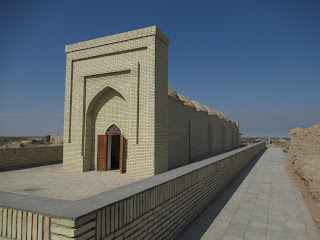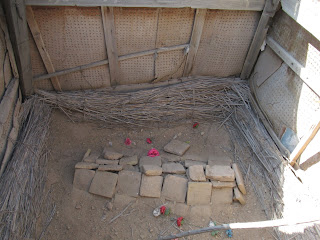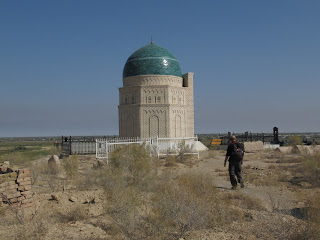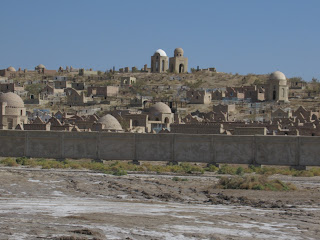We had arrived very late the previous night in Uzbekistan's far northwestern city of Nukus from the capital of Tashkent almost exclusively to see one of the best collections of Soviet art in the world as we are big museum buffs. The far more minor reason was to visit Mizdakhan, an ancient and vast necropolis and once the second largest city in the region. However, when we met a younger German couple in the hotel that morning, the four of us decided to share the $30 cost of going there together by taxi as it was located about a half hour's drive away. For that price, the driver would wait for us with no set time to return.
Credit for much of the information in this post goes to Sudhagee, a travel blogger from Mumbai, India, who wrote so eloquently of her visit to Mizdakhan in 2015.
Mizdahkan, on the way to the Uzbekistan-Turkmenistan border crossing, was spread over three low-lying hills and covered an area of about two square kilometers. The complex, founded over two thousand years ago, currently ranks as the oldest cemetery in Uzbekistan. However, it wasn't a cemetery in the usual sense - a place where humans find their last refuge. The site is full of mysteries and mysticism and to this day remains a place of pilgrimage.
Mizdahkan appeared quite suddenly in an otherwise flat landscape. One moment we were driving past Soviet-style bloc construction separated by vast stretches of emptiness. The next moment there were thousands of graves, tombs and mausoleums stretching almost as far as the eye could see just beyond a low wall.
While Mizdahkan is known as a necropolis today, in the distant past it was the name of an ancient city that existed here. According to archaeological findings, the area was continuously occupied from about 400 BC until about 1400 AD. Mizdahkan faced three major invasions during this period.
According to Sudhagee's blog, the earliest burials at Mizdahkan have been dated to around 2nd century BC and are attributed to semi-nomadic tribes. The next set of burials date from the 4th to the 8th centuries AD and are Zoroastrian ossuary burials - interring of bones in a box after being stripped of the flesh by birds and the sun. She noted evidence of Christian burials at Mizdahkan from the 7th century although we didn't see any. The first Muslim burials at Mizdakhan dated from the 9th century.
The ‘modern’ graves were simple graves without any tomb-like structure covering them. Instead, a wooden structure that looked like a horizontally-placed ladder covered the grave. Sudhagee's guide told her in this local custom, dead bodies were brought to the burial ground on these ladder-like structures. After the burial, the ‘ladder’ would be placed on the grave in a horizontal position. I surmised the metal barricades acted to both mark and protect the graves.
Thanks to Sudhagee for providing the following background information about the mausoleum. "Mazlum Khan was the beautiful daughter of the local governor. Naturally, she was desired by all the local bachelors. But Mazlum was in love with a builder, and a rather poor one. Her father announced that he would let his daughter marry the man who could build a tall minaret in one night. One man completed the task - the builder.
But unfortunately, this love story did not have a happy ending as the governor refused to honor his promise. The young builder jumped off from the top of the minaret he built and the heartbroken Mazlum followed suit. The distraught and repentant governor ordered the minaret to be destroyed. He also ordered for the lovers to be buried together and a mausoleum built over their graves from the bricks of the destroyed minaret.
Over the centuries, the Mazlum Khan Mausoleum fell into a serious state of disrepair. Following archaeological excavations, it underwent restoration over a twenty-year period from the 1960s to the 1980s. Except for the bricks and tiles in the lower portion of the mausoleum, everything else was new. The newness of the blue-tiled dome was particularly striking after the plain, mud brick exterior."
As Mizdakhan is a pilgrimage site, people had come to pray and honor those who had died.
These were the first and what turned out to be the only crosses we saw while at Mizdakhan. I wondered if they were put up on purpose or by 'mistake.'
According to Sudhagee's blog, some of the older mausoleums at Mizdahkan have acquired a reputation of being holy and being able to grant specific wishes. One, she wrote, was Shamun Nabi’s Mausoleum. As Shamun Nabi or Prophet Shamun was supposed to be literally a giant among men, his tomb was 25 meters long!
My thanks to Sudhagee for the following information. It is believed that the tomb grows an inch every year in length due to Shamun Nabi’s powers to grant good health and strength. While the exterior of the mausoleum was the same mud-colored brick as others, the interior had whitewashed walls and exposed brickwork in the seven domes arranged along the length of the tomb.
The highest point at Mizdahkan is the Djumarat Khassab Mound, which is named after a khassab or butcher named Djumarat. Sudhagee explained the butcher became famous as he used to distribute meat to the poor and needy during hard times. He was respected by the local people, which over time turned into reverence. After being regarded as a holy man, his special power was the ability to bless the childless with children. Sudhagee wrote that it is a common local practice for childless women to climb up to the mound and roll down its gentler side, all the while praying for a child. What I wouldn't have given to see that.
The view from the top of Djumara Mound also known as Execution Hill but I don't know why. This was the structure the custodian had pointed out before to us.
Graves as far as we could see in every direction:
These white graves stuck out from all the others which were all mud-colored. Perhaps these weren't yet completed and would soon receive the same exterior as the others?
This grave was heartbreaking as it was the smallest one at Mizdakhan and must have been for a baby or small child. I had thought right from the moment we entered Mizdakhan that the metal enclosures around the graves looked like baby cribs - this even more so.
The most interesting structure in Mizdahkan was also the one with the most interesting stories associated with it. Some archaeologists believe the large squarish ruin, with two very distinct types of brickwork, was a madrassa or religious school, which was destroyed by Timur when he invaded the region. Local belief, however, is divided between this being the mausoleum of Caliph Yerejeb, a holy man, or the site where Gayomard, the first human being according to Persian mythology is buried, or the site where Adam is buried.
Such columns can be seen all over the area around the building. Obviously, there are more people who thus want their wishes to come true than there are stones. So disassembling others' columns to create one’s own is allowed. The only condition is that the stones must not be taken away. It is believed to have very bad consequences.
So why did all the columns or rock piles have seven stones, and not eight, nine or just three? Sudhagee said it was connected with Mizdahkan’s other shrine, the Shamun-Nabi Mausoleum, we'd seen earlier. Shamun-Nabi, a giant, strong man and a holy person deeply revered in Central Asia, was an epic Muslim hero, who, according to legend, was locked in combat with a heathen from neighboring Gyaur-Kala, the fortress of fire worshippers.
When he died, he was believed to have been buried in the mausoleum with seven domes as that corresponded with the number of daughters he had. By building a column of seven stones, a person therefore appeals to Shamun-Nabi. Judging by the massive number of columns of seven rocks, many people have made their appeals to Shamun-Nabi at Mizdakhan.
It was profoundly humbling witnessing the testaments of faith. To later read and understand what we'd seen throughout the religious complex at Mizdakhan thanks to Sudhagee made me appreciate what we'd experienced at Mizdakhan a thousandfold more.
Waldheim and Anna, the wonderful German couple from near Leipzig, Steven and I didn't even need to ask the driver to take us to ruins of Gyaur-Kala, the neighboring hill near the Turkmenistan border, that we'd also hoped to see. He just drove us over to view the remains of the 3rd century BC fortress. On the way, we drove past several salt beds in the desert.
As there were no descriptions and no one to ask about what we saw in these ruins, we just wandered and let our imaginations take flight as to what may have been.
Waldheim and Anna decided to do more exploring than we felt comfortable doing in the uneven terrain at the fortress as the memories of that long hike in the mountains near Osh were still fresh in our minds.
Our last look at the amazing Mizdakhan that had far surpassed our expectations of what we anticipated would be a second-tier site at Nukus.
Credit for much of the information in this post goes to Sudhagee, a travel blogger from Mumbai, India, who wrote so eloquently of her visit to Mizdakhan in 2015.
Mizdahkan, on the way to the Uzbekistan-Turkmenistan border crossing, was spread over three low-lying hills and covered an area of about two square kilometers. The complex, founded over two thousand years ago, currently ranks as the oldest cemetery in Uzbekistan. However, it wasn't a cemetery in the usual sense - a place where humans find their last refuge. The site is full of mysteries and mysticism and to this day remains a place of pilgrimage.
Mizdahkan appeared quite suddenly in an otherwise flat landscape. One moment we were driving past Soviet-style bloc construction separated by vast stretches of emptiness. The next moment there were thousands of graves, tombs and mausoleums stretching almost as far as the eye could see just beyond a low wall.
While Mizdahkan is known as a necropolis today, in the distant past it was the name of an ancient city that existed here. According to archaeological findings, the area was continuously occupied from about 400 BC until about 1400 AD. Mizdahkan faced three major invasions during this period.
The first was in the 8th century when Arabs invaded the region intent on destroying Zoroastrianism, the existing religion in the region, and establishing Islam. The second major sacking of Mizdahkan was in 1221 when the Mongols, led by Genghis Khan invaded the city. The third and final attack was in 1388 by Timur, who destroyed everything except the burial sites. Mizdahkan did not recover from Timur’s invasion and ceased to be a city for the living. It, however, grew as a city for the dead as burials continued at Mizdahkan, a practice that continues today.
A sign of life amid the city of the dead:
In the background, you can see where we entered Mizdakhan from the long, white wall that separated the necropolis from the road and then the thousands of graves on the hillsides.
After climbing the eastern hill, we were faced with the sight of hundreds and hundreds of more graves. We almost passed by the very unassuming entrance to the most elaborate mausoleum at Mizdahkan, that of Mazlum Sulu Khan, as the unusual mausoleum was almost entirely built underground. Built in the late 12th or early 13th century, all that was visible from the outside was a large dome with an opening that had steps leading underground. It would have been so easy to walk right on by without seeing the masterpiece within. But unfortunately, this love story did not have a happy ending as the governor refused to honor his promise. The young builder jumped off from the top of the minaret he built and the heartbroken Mazlum followed suit. The distraught and repentant governor ordered the minaret to be destroyed. He also ordered for the lovers to be buried together and a mausoleum built over their graves from the bricks of the destroyed minaret.
Over the centuries, the Mazlum Khan Mausoleum fell into a serious state of disrepair. Following archaeological excavations, it underwent restoration over a twenty-year period from the 1960s to the 1980s. Except for the bricks and tiles in the lower portion of the mausoleum, everything else was new. The newness of the blue-tiled dome was particularly striking after the plain, mud brick exterior."
As Mizdakhan is a pilgrimage site, people had come to pray and honor those who had died.
The mausoleum's vastness and beauty left us both speechless.
These were the first and what turned out to be the only crosses we saw while at Mizdakhan. I wondered if they were put up on purpose or by 'mistake.'
This was the newest grave site we saw. Unlike the others, the 'ladder' was at the back and not on top of the grave.
We kept seeing what we thought were cairns - stacked rocks normally built as a landmark or memorial - everywhere but I didn't realize the significance until I came across Sudhagee's blog after our visit. More later on the rock piles - one important fact was the number of rocks piled on top of each other although we didn't know it then!
A custodian with minimal English pointed to the structure on the hill and indicated somebody had his throat slit there. Figured we'd wait on going there for a bit on hearing that bit of news!
My thanks to Sudhagee for the following information. It is believed that the tomb grows an inch every year in length due to Shamun Nabi’s powers to grant good health and strength. While the exterior of the mausoleum was the same mud-colored brick as others, the interior had whitewashed walls and exposed brickwork in the seven domes arranged along the length of the tomb.
This new mausoleum differed in shape from all the others.
The highest point at Mizdahkan is the Djumarat Khassab Mound, which is named after a khassab or butcher named Djumarat. Sudhagee explained the butcher became famous as he used to distribute meat to the poor and needy during hard times. He was respected by the local people, which over time turned into reverence. After being regarded as a holy man, his special power was the ability to bless the childless with children. Sudhagee wrote that it is a common local practice for childless women to climb up to the mound and roll down its gentler side, all the while praying for a child. What I wouldn't have given to see that.
The view from the top of Djumara Mound also known as Execution Hill but I don't know why. This was the structure the custodian had pointed out before to us.
There looked to be a tomb in the bottom of the concrete structure.
As we made our way down the hill, we were very careful not to disrupt the carefully laid piles of rocks even though we didn't know then why they were there.
This was the only grave we saw that wasn't enclosed.
We headed next toward the beautiful turquoise-domed mausoleum that we had noticed from Djumarat Mound as it also was different from both the older and newer mausoleums. When we got there though, the gate was locked so we could only view it from the outside. These white graves stuck out from all the others which were all mud-colored. Perhaps these weren't yet completed and would soon receive the same exterior as the others?
This grave was heartbreaking as it was the smallest one at Mizdakhan and must have been for a baby or small child. I had thought right from the moment we entered Mizdakhan that the metal enclosures around the graves looked like baby cribs - this even more so.
I found Sudhagee's description of the ruin being known as the ‘world clock' to be absolutely riveting. "It wasn't a traditional clock we see all around us. Why is it a clock, then? And a ‘world clock’ at that? It's because there is a very strong local belief that each year the building misses one brick in its brickwork. And when the brickwork collapses, that will be the end of the world.
Currently there is about one third of the construction missing. It is easy to calculate that the lifespan of the humanity is around 3,000 years, which means that the world will come to an end one thousand years after 2012, the date prophesied by the Incas."
There are more beliefs associated with the construction, however. Sudhagee added a person who erects a column using seven of the stones that have fallen off the structure and makes a wish will have it come true. To delay the eventual ending of the world, people stack the loose bricks in piles of seven, and ask for a wish as they do so. Such columns can be seen all over the area around the building. Obviously, there are more people who thus want their wishes to come true than there are stones. So disassembling others' columns to create one’s own is allowed. The only condition is that the stones must not be taken away. It is believed to have very bad consequences.
So why did all the columns or rock piles have seven stones, and not eight, nine or just three? Sudhagee said it was connected with Mizdahkan’s other shrine, the Shamun-Nabi Mausoleum, we'd seen earlier. Shamun-Nabi, a giant, strong man and a holy person deeply revered in Central Asia, was an epic Muslim hero, who, according to legend, was locked in combat with a heathen from neighboring Gyaur-Kala, the fortress of fire worshippers.
Waldheim and Anna, the wonderful German couple from near Leipzig, Steven and I didn't even need to ask the driver to take us to ruins of Gyaur-Kala, the neighboring hill near the Turkmenistan border, that we'd also hoped to see. He just drove us over to view the remains of the 3rd century BC fortress. On the way, we drove past several salt beds in the desert.
As there were no descriptions and no one to ask about what we saw in these ruins, we just wandered and let our imaginations take flight as to what may have been.
Our last look at the amazing Mizdakhan that had far surpassed our expectations of what we anticipated would be a second-tier site at Nukus.
The three tired amigos on the way back to Nukus!
Next post: Seeing the Savitsky Collection, the reason why we went all the way to Nukus - the plans of mice and men!
Posted on October 17th, 2018, from Almaty, Kazakhstan.





































































Well done.History lesson completed.
ReplyDeleteMizdakhan far surpassed our expectations which were low admittedly in advance. Think our experience was a definite highlight of our trip to Uzbekistan as it showed us something far different than the ancient mosques, madrassas and mausoleums we had expected to find.
ReplyDelete